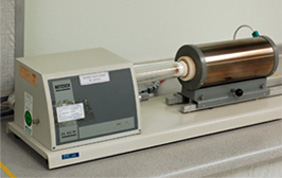Thermoanalytical methods such as dilatometry and TG-DTA yield crucial information that is used to characterise the suitability of new materials, troubleshoot defects and monitor the quality of incoming raw materials.
Dilatometer
Dilatometry analysis is a method for the determination of dimensional changes versus temperature when the sample undergoes a controlled temperature programme. There are two types of dilatometry analysis namely irreversible and reversible thermal expansion.
a) Irreversible thermal expansion
This is expansion/shrinkage of a dry, unfired material as it is subjected to a heating process. Evaluation of the expansion during firing can provide useful information such as identification of the type of clay be it kaolin, illite...etc
b) Reversible thermal expansion
Reversible dilatometry analysis is performed on fired ware samples such as fired clay, body and glaze samples to measure the coefficient of thermal expansion (COE). This parameter determines to a certain extent the compatibility of the ceramic body and glaze. Incompatibility could lead to crazing of the glaze and also affects its planarity.
 Dilatometer for Thermal Expansion
Dilatometer for Thermal Expansion Analysis of dilatometer revealed:
- Irreversible thermal expansion
- Reversible thermal expansion (COE)
- Sintering temperature
- Softening points
- Onset of sintering
- Influence of additives